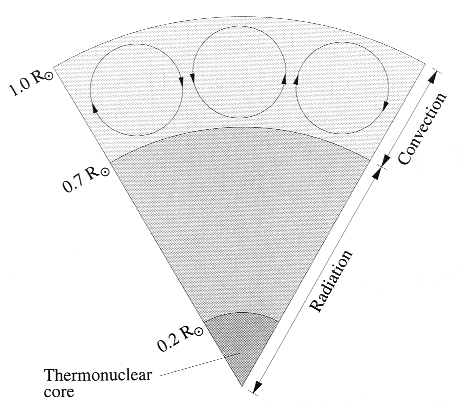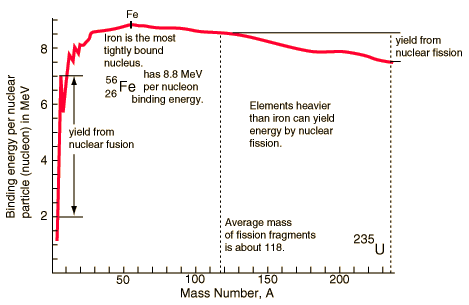We just discussed
the energy released when 4 hydrogen are fused into helium. Each reaction
requires that the strong electrostatic repulsion of the protons be overcome.
This requires high temperatures (so that the nuclei are moving rapidly)
and high densities (so the nuclei are close together). The process
is aided by quantum mechanical tunnelling, where a particle has a finite
probability of going through a potential barrier rather than over
it.
The fusion of hydrogen to
helium is accomplished not in one step, but through a chain of reactions
called the proton-proton chain.
In fact, there are three different chains that lead to the same result,
as shown below. These occur in the Sun with the percentage shown
in the table labels.
|
PP I Chain (69%)
|
|
11H + |
|
11H => |
|
21H + e+ |
|
+ ne |
|
|
|
|
|
|
|
|
|
21H + |
|
11H => |
|
32He + g |
|
|
|
|
|
|
|
|
|
|
|
32He + |
|
32He => |
|
42He + |
2 |
11H |
|
PP II Chain (31%)
|
|
32He + |
|
42He => |
|
74Be + g |
|
|
|
|
|
|
|
|
|
|
|
74Be + |
|
e-
=> |
|
73Li + ne |
|
|
|
|
|
|
|
|
|
|
|
73Li + |
|
11H => |
|
2 42He |
|
|
|
PP III Chain (0.3%)
|
|
74Be + |
|
11H => |
|
85B + g |
|
+ ne |
|
|
|
|
|
|
|
|
|
|
|
85B => |
|
84Be + e+ |
|
+ ne |
|
|
|
|
|
|
|
|
|
|
|
84Be => |
|
2 42He |
|
|
A second, independent cycle
called the CNO cycle also occurs to convert hydrogen to helium. This
cycle requires the presence of carbon, nitrogen and oxygen, but does not
consume them. They play the role of a catalyst. Although the
CNO cycle is not very important for the Sun, it is much more strongly temperature
dependent than the PP chains, so it dominates for massive stars.
Most stars also convert He to C at some point in their lives, in a process
known as the triple alpha process,
and other, heavier elements are also "burned" inside stars as we shall
see.
Energy is generated
by both gravity (throughout the star) and nuclear reactions (in the core),
but most of the energy by far comes from the core, where the temperatures
and densities are high enough to allow fusion to take place. This
energy must then find its way to the surface of the star, to be radiated
away. There are three main ways for energy to be transported:
-
conduction (efficient only for
solids and liquids, not for gases)
-
convection (boiling)
-
radiation (photons)

Schematic diagram of the interior of the Sun, showing regions of thermonuclear
burning, energy
transport by radiation, and energy transport by convection. Other
stars have different details,
but the same basic structure applies. Figure from Carroll
and Ostlie, Introduction to Modern
Astrophysics, Addison-Wesley, New York, 1996.
The latter two mechanisms
are competing mechanisms in stars. Convection occurs when the temperature
falls rapidly with height (a steep temperature
gradient, dT/dr).
Imagine a rising parcel of gas--as it rises it expands (because the outside
pressure drops). It also cools due to the expansion (adiabatic expansion),
but if the temperature of the outside surroundings falls even faster then
it will be buoyant. This situation is then unstable and the parcel
of gas will continue to rise.
When the star has a shallow
temperature gradient, it is stable to convection and the only
mechanism left is radiation. Then the photons carry the radiation,
but they carry it very slowly. Photons take 106
years to reach the surface of the star!
Most stars, including the
Sun, have radiative cores and convective envelopes. The Sun is convective
from 0.7 Rsun
to the surface. We see that whether stars carry energy by radiation
or convection depends on the way that temperature varies with radius in
the star. How does the temperature vary within the star? Except
where it is generated in the core, each layer of the star merely transports
energy.

